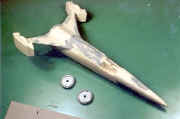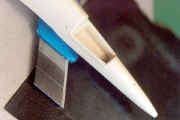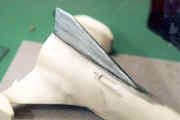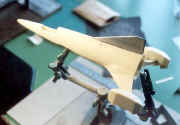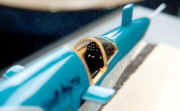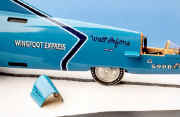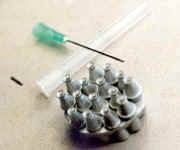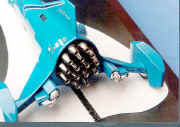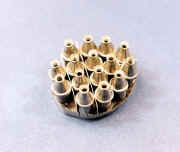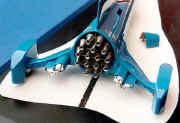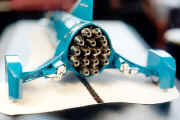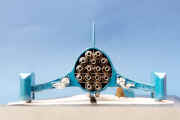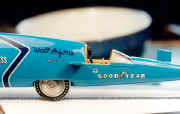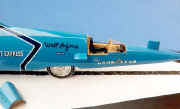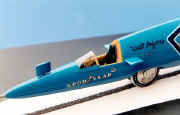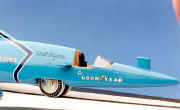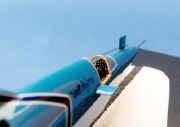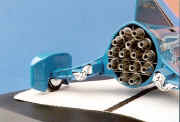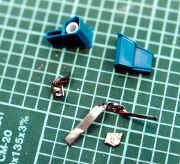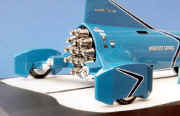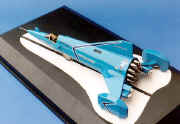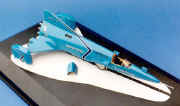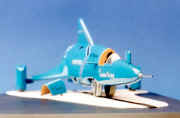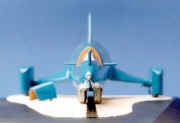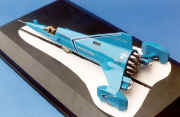|
Legal Notice
No material from Modeler Site any Web site owned, operated, licensed, or controlled by Damian Covalski may be copied, reproduced, republished, uploaded, posted, transmitted, or distributed in any way, except that you may download one copy of the materials on any single computer for your personal, non-commercial home use only, provided you keep intact all copyright and other proprietary notices. Modification of the materials or use of the materials for any other purpose is a violation of Damian Covalski's copyright and other proprietary rights.
Read More here > Legal notice
|
Unpacking and assessing the kit
The kit consists of 49 parts, with the main body, including outriggers, wheel spats and rear wheels, cast very cleanly in resin. The parachute housings and the canopy are also cast resin, whilst all the other parts are cast metal (including the front "tires"). There is is also a clear vac-formed windscreen and a piece of tissue to simulate the packed parachutes, and the decals of course.
|
The cast metal parts are very crisp indeed, the windshield is clear, and the decals are very opaque and nicely printed, although their design could be a bit crisper (the white linings of the dark blue stripes should be finer).
|
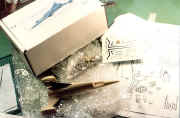
|
Comparison with pictures showed that the shape of the body is spot on, the detailing quite correct, and additional details could be added without too much effort. Apart from the rear end, where I would have liked to see more details, the kit is well detailed, but then, there is always room for improvements, and the essential details are all there.
I decided that I wanted to add some bits and pieces to the rear end, like including part of the racks that hold the rockets, adding brake lines and some rivets or bolt heads, and to do something about the parachutes. The cockpit area was more difficult a task, and as I had no pictures of the cockpit interior, I decided that I would just leave it the way it was. The only things I had noticed were some details missing on the bulkhead behind the drivers seat (I recreated them using plastic card and rod) and the canopy rails, which are cast with the main body, but will look much better (and correct) as separate pieces. So I cut and sanded the cast "rails", and made new ones (separate for the canopy at the rear, and the windscreen at the front) from aluminum sheet, with rivets simulated with a 0.3mm drill-bit.
The nose probe was replaced by a piece of injection needle (after all, the real thing was a tube…).
Basic assembly and painting
The tail fin was glued to the main body, making sure it sits absolutely straight. The join line at the base of the fin was filled with gap filling super-glue, then sanded smooth.
|
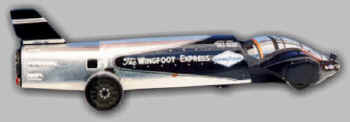
|
|
1964 "The Wingfoot Express"
|
|
|
History
The history of the ultimate test in speed, the Land Speed Record, saw some action on the salt flats in 1964! After Briton Donald Campbell, son of the King of Speed himself, Sir Malcolm Campbell, had set a new outright LSR of 403.10 mph (648.78 km/h) with his Bluebird CN7 on (dry-) Lake Eyre in Australia on July 17, a real battle between LSR enthusiasts took place on the Salt Flats near Bonneville. Walt Arfons' The Wingfoot Express, Art (Walt´s brother!) Arfons' Green Monster and Craig Breedlove's Spirit of America took turns in raising the 3 months old record. The least lucky was perhaps Walt Arfons. Although his Wingfoot Express, driven by Tom Green (who had actually built the car) snatched the record from Campbell at 413.20 mph (664.98 km/h) on the 2nd of October 1964, he lost it only 3 days later to his brother's car, which passed the 1-mile-distanced
timing traps at an average of 434.02 mph (698.49 km/h) for the mandatory two runs (one in each direction, performed within one hour). The record changed hands 3 more times between Art Arfons and Craig Breedlove, until on October 27 the Green Monster concluded the 1964 records with a staggering 536.71 mph (863.76 km/h). The Wingfoot Express had held the record for a mere 3 days, but Walt Arfons was determined to come back with a new car, with a new concept.
He then built the first real rocket-powered contender for the outright LSR. Others had tried this kind of propulsion before him; Fritz von Opel had powered vehicles from cars to train-sleds with solid fuel rockets, albeit without any serious LSR ambitions. Even Mickey Thompson is known to have experimented with additional power from rockets on his Challenger 1. But until Arfons' creation, none had ever seriously engineered an LSR contender around that concept of propulsion.
Walt Arfons designed a car often described as looking like an Atlas rocket lying on it's side. The car sure looked like it would go faster than anyone before, even a supersonic record seemed to be within reach, but eventually little success would come from the experience.
The JATO-rockets ("jet assisted take-off" rockets, designed to help military planes to take off "more easily") had too short a burn time to last through the entire length of the course; even when fired in sequences (which initially had to be done manually by the intrepid driver Bobby Tatroe), the rockets would usually burn out long before exiting the timing trap, the car merely coasting along (at some 400 mph!), and slowing down considerably even before the end of the timing trap. With the initial 15-rockets configuration, the best top speed thus recorded was way below the record which stood at 536.71 mph (average).
Even with the addition of 10 more rockets (protruding from the sides of the "fuselage") success was not at hand, and Bobby was even lucky to escape unhurt from a spectacular burn-out! The LSR scene would have to wait another 5 years before the first rocket car, The Blue Flame, would claim the speed-crown.
The car, even if not an LSR holder, is surely one of the most terrific designs that ever hit the saltflats, and Pandora Models, one of the few companies who have dedicated their efforts to the creation of high quality replicas of record vehicles, both in kit and built form, have done a very nice job, capturing the shape and lines of the car with expertise. Congratulations!
|
|
Pandora recommend F A first coat of primer, subsequently sanded, eliminated minor blemishes and scratches. The second coat of primer, once sanded, was a perfect basis for the color Electric Blue/Monza Blue for the body, the canopy, the canopy/windscreen rails and the parachute housings, and it turned out to be a very nice color, making the model look like the actual car; so it must be right!
Three light coats of blue were sprayed (I use automotive spraycans), then the car was set aside to allow the color to dry/harden thoroughly.
The rockets
Meanwhile the other parts were prepared; the rockets are simply polished to a good sheen (although they were not chrome silver on the actual car, I preferred not to paint them aluminum or the like). The same was done to the cockpit floor and the front wheel covers (or hubcaps). The shine on the latter one's turned out to be uneven; maybe they would look better if painted chrome-silver. For those who have a lathe, turned aluminum hubs will of course be the only choice! I modified the rocket assembly, first, because I couldn't put all the rockets in their places (although the instructions say something about the rockets being cast slightly off-center, so you can turn them to arrange and fit all of them), and second, because I thought the assembly would look more realistic, somehow deeper.
So I painted the kit supplied support-rack black, laid it on a piece of paper,
and glued the rockets into the holes, flush with the underside. Now, there was more room for the rocket-heads, and all of them fit side by side. As the rockets now protruded some 8mm more than intended by Pandora, I had to remove the cast locating tabs inside the rear fuselage, thus allowing the rocket-assembly to locate deeper inside the fuselage, with the rear end of the rockets protruding at a correct length from the body. Before the epoxy glue set, I inserted three strips of aluminum sheet (disposable oven pan), to simulate some sort of support-brackets. They looked a bit different on the real thing; I had replicated the real thing, but just to find out that there was not enough place to fit it, so I dropped it!
A glass-smooth finish...
The other parts were primered, then painted matte or semi-gloss black, according to what the instructions and/or pictures suggested. The dashboard and steering wheel were detail painted with Testors chrome silver and Tamiya stained glass colors. The front tires were lightly drybrushed with light gray and earth (rubber tires are definitely not simply dead flat black!).
After the blue color had thoroughly dried, the body and canopy were sanded smooth, and the decals applied with the help of some Solvaset. As I was going to varnish the decorated model, I applied Solvaset twice to the entire decals, thus making sure that no air would be left trapped under the decals, which would have caused them to melt and dissolve under the varnish. As always, two light, and one heavy coat of varnish (spraycan) were applied, and the model was then set aside to dry for the next two weeks. Sanding was done as always, using polishing cloths with grades ranging from 4000 grit to 12000 grit. Final polishing was done with liquid automotive polish, and automotive wax sealed the glossy surface.
Now, one word concerning high gloss finishes on model cars: Race cars from the 60's (and earlier periods, of course) were not always that shiny, and some modelers prefer not to reproduce mirror like sheen on miniatures of those periods. LSR vehicles, on the other hand have always been more neatly finished than their contemporaries, because wind resistance has a nasty tendency to build up on whatever is at hand, including bad paint-jobs. A near glass-smooth finish on an LSR model, especially considering scale effect, is surely no major fault.
The cockpit
The cockpit area was masked off using a plastic bag, Parafilm M, and Bare Metal Foil. The instructions don't give a color reference for the cockpit interior, but the decal sheet includes a gold colored decal for the rear bulkhead. Now, I thought that in the picture on page 186 in "The fastest Men on Earth; 100 years of the Land Speed Record" (by Peter J.R. Holthusen) it looks more like yellow, or orange; so I bought a can of Tamiya TS34, which is pure guesswork, but it looks very much like that picture, and so far, nobody has objected… The interior, the scratch-built bulkhead and the windscreen-support (slightly reshaped) were painted yellow. Gentle heat was used to correct the shape of the windscreen, which was just a bit too narrow.
The Parachute
The parachute packs were made from lead-foil, as were the straps that link the parachute to the cord (stored in the smaller housings). Matte white primer was used to paint them. The rear brake lines come from Detail Master, the bolt heads on the inside of the rear wheel spats are from Grant Line. The rear "tires" were painted matte black, then drybrushed in the same manner as the front ones. Matte aluminum Bare Metal Foil was used to replicate the wheel-hubs.
I assembled the front wheels using the magnetic gluing jig, which helps to achieve a perfectly parallel fit.
|
Final assembly and display
Final assembly was straight forward with the use of 5-minute epoxy. I let the model dry for a day, then set it on a piece of sanding paper, glued to a glass plate, and sanded a flat spot onto all of the tires (the rear ones have such a flat spot cast into them anyway). This gives the model a nice sit on the ground, rather than "levitating" on microscopic contact points.
|
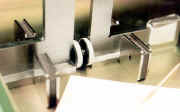
|
|
Aligning the front wheels
|
The base comes from BBR models (Italy), with a nice dust-proof clear cover; it is intended for 1/24th scale models, but works just fine for these large 43rd models. I wanted to place the model on a piece of salt flats, roughly the shape of the car, so a piece of sanding paper, painted matte white, with the black line drawn with a permanent marker was used. Unfortunately I simply forgot to add tire marks! I had planned to apply the "old" method of subtly drybrushing them (see "Wingfoot 1" review in June edition of amazing43.com), but then I got carried away.
Holes were drilled into the bottom (flat spot) of all of the four tires, and the position of these holes transferred to the base plate. Small screws secure the model to the base. Finally all fingerprints and dust particles were removed from the model, and the canopy glued to the ground, alongside the vehicle.
Conclusion
I really enjoyed building this model. It is nicely detailed, still offers the possibility to add more details as you build along. The instructions are good, the decal sheet comprehensive, and the quality of the parts is very good. The only "nag" is, that I would have preferred to have separate rear wheels.
I recommend this kit to whoever wants to start or complete an LSR vehicle collection. Building this kit took about 24 very agreeable hours.
References
"The Land Speed Record" Shire Album N° 263, David Tremayne
"Land Speed Record", Cyril Posthumus & David Tremayne
"100 years of the World's Land Speed Record 1898-1998; Part 2 The second half century", Ferdinand C.W. Käsmann
"The fastest Men on Earth; 100 years of the Land Speed Record"(1), Peter J.R. Holthusen
"The Land Speed Record 1947-1997 as chronicled in the UK Motoring Press", Transport Source Books
"Fast Facts", The Speed Record Club Quarterly Newsletter, N° 20
"Vitesse Illimitée; L'histoire du record absolu de vitesse de 1898 à nos jours", William Huon
(1) contains some very interesting color pictures of different LSR cars, but some say the accuracy of the text is questionable
Special tools/materials used
Magnetic Gluing Jig, NWSL (via Micro Mark)
Bare Metal Foil (Matte Aluminum)
Detail Master "0.012 in. Detail wire, black"
Grant Line, nuts & bolts
Lead foil (from a good, old bottle of whine; most younger whines don't have lead foil any more, as it has been banned for health reasons; lead foil is also available from Verlinden Productions as a military diorama accessory)
Support us ordering our notes in PDF > Here
|




